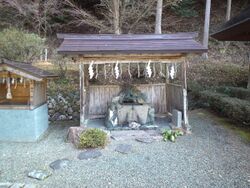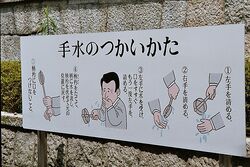Religion:Chōzuya
Chōzu-ya or temizu-ya (手水舎) is a Shinto water ablution pavilion for a ceremonial purification rite known as temizu or chōzu (手水, lit. hand-water). The pavilion contains a large water-filled basin called a chōzubachi (手水鉢, lit. hand water basin).
At shrines, these chōzubachi are used by a worshipper to wash their left hand, right hand, mouth and finally the handle of the water ladle to purify themselves before approaching the main Shinto shrine or shaden (社殿). This symbolic purification is normal before worship and all manned shrines have this facility, as well as many Buddhist temples and some new religious houses of worship. The temizu-ya ("temizu-area"[citation needed]) is usually an open area where clear water fills one or various stone basins.[citation needed] Dippers (hishaku (杓)) are usually available to worshippers. In the 1990s, water for temizu at shrines was sometimes from domestic wells, and sometimes from the municipal supply.[1]
Originally, this purification was done at a spring, stream or seashore and this is still considered the ideal.[failed verification] Worshippers at the Inner Shrine at Ise still use this traditional way of ablution.[2]
See also
- Chōzubachi
- Glossary of Shinto
- Harae, a term for all Shinto purification rituals, including temizu
- Misogi, a Shinto ritual of full-body purification
- Ritual purification
- Tsukubai, a wash basin for visitors in Japanese Buddhist temples or roji
- Ablution in Christianity
- Wudhu
References
- ↑ K Yokoi, R Nawata, S Furui, T Nagasawa, S Yanase, M Kimura, Y Itokawa (December 1991). (in ja)Nihon Eiseigaku Zasshi 46 (5): 1009–13. doi:10.1265/jjh.46.1009. PMID 1779475.
- ↑ Mori Mizue. "Temizuya" (in en). http://k-amc.kokugakuin.ac.jp/DM/detail.do?class_name=col_eos&data_id=22431.
- Sokyo Ono; W. P. Woodard (1998). Shinto: the Kami Way. Rutland, VT: Tuttle. ISBN 9780804819602.
- Kazuo Nishi; Kazuo Hozumi; H. M. Horton (1996). What is Japanese architecture. Tokyo: Kodansha. ISBN 9784770019929.
Further reading
- "chouzubachi". Japanese Architecture and Art Net Users System. Atsumi International Scholarship Foundation. http://www.aisf.or.jp/~jaanus/deta/c/chouzubachi.htm., and links therein
 |




